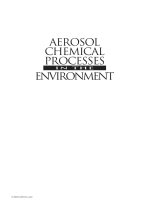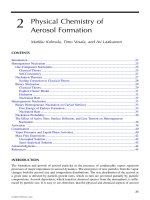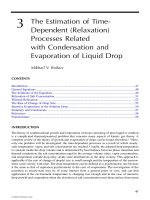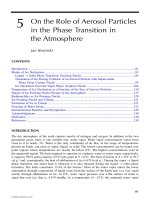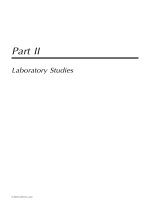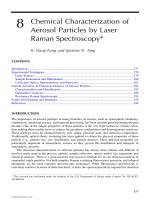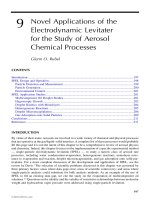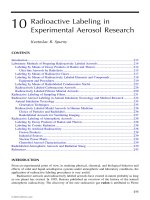AEROSOL CHEMICAL PROCESSES IN THE ENVIRONMENT - CHAPTER 11 docx
Bạn đang xem bản rút gọn của tài liệu. Xem và tải ngay bản đầy đủ của tài liệu tại đây (302.86 KB, 8 trang )
Part III
Aerosol Synthetic Chemistry
L829/frame/ch11 Page 247 Tuesday, February 1, 2000 3:55 PM
© 2000 by CRC Press LLC
249
11
Synthesis and Online
Characterization of Zirconia
Powder Produced
by Atomization
Claude Landron
CONTENTS
Introduction 249
X-ray Absorption 250
Sample Elaboration 251
EXAFS Experiments 251
Results and Discussion 252
Conclusion 254
References 255
INTRODUCTION
New manufacturing techniques for ceramic processing have been carefully explored as means of
producing powders with a variety of well-defined characteristics. The quality of the final product
can be significantly improved by the choice of an efficient production process. The control of the
shrinkage depends drastically on the size and on the microporosity of the particles. It is well-known
that the formation of hollow spheres has a negative effect on densifying and sintering. Another
important problem related to the particle shape is illustrated by the fact that strongly agglomerated
powders give difficulties in sintering conventional powders. Atomization is an alternative procedure
that presents many advantages to produce ceramic.
1
It has been used to elaborate high-Tc super-
conductor powders.
2
As a matter of fact, the synthesis of powders by the spray pyrolysis of the
precursor solution can be considered a containerless experiment. Thus, chemical segregation of
cations is reduced to a single microsized drop, thereby ensuring good stoichiometry control. Among
the techniques for preparation of aerosols (such as condensation methods, dispersion methods,
electrical atomization, vibrating orifice technique), we have selected ultrasonic atomization, which
is suitable for controlling the distribution of the powder particle size.
Although aqueous solutions occupy an important place in material chemistry, relatively few
studies have dealt with structural investigations of the liquid state, for which detailed, accurate
information related to atomic distance and coordination number would be useful. It has been shown
3
that a liquid zirconium precursor used at high concentration reproduces an environment similar to
that of crystallized compounds. In recent years, new methods for the characterization at the
micrometer scale of small liquid particles which play an increasingly important role in many fields
of material science, has been developed with high spatial and temporal resolution. EXAFS
L829/frame/ch11 Page 249 Tuesday, February 1, 2000 3:55 PM
© 2000 by CRC Press LLC
250
Aerosol Chemical Processes in the Environment
(Extended X-ray Absorption Fine Structure) is presently the best
in situ
technique that can be used
to detect differences on the Angstrom scale in precursor transformation during ceramic synthesis.
This spectrometric technique gives accurate information concerning the environment of the cations
and the presence of anions in the coordination sphere, which has an effect on the structure of the
final product. This chapter describes the modification of the environment of Zr
4+
cations in samples
selected during zirconia synthesis by an atomization route. An
in situ
structural approach is
developed in association with zirconia (ZrO
2
) powder processing.
X-RAY ABSORPTION
Interest in local structure determination has recently stimulated the growth of EXAFS studies.
4
The
principal advantage of this spectrometry is that it is particularly suitable for the study of disordered,
glassy, or vitreous materials.
4
EXAFS is based on the measurement of the attenuation of X-ray beam
propagation in a condensed medium. Attenuation results from three principal processes: pair produc-
tion, scattering, and photoelectric absorption. In the energy range of the X-rays used in EXAFS (1
to 20 keV), photoelectric absorption dominates the attenuation process. The atomic distribution of a
selected atom is obtained by Fourier transforming the EXAFS signal as a function of incident photon
wavenumber. This oscillating signal is related to the variation of the absorption cross-section for the
photoexcitation of an electron from a deep core state to a continuum state. The oscillations of the
absorption spectrum above an absorption edge of one particular type of atom is related to the final
state of the excited atom. They result from the interferences between the wave function of an outgoing
photoelectron that is emitted during the photoemission process and the part of this wavefunction that
is reflected by the neighboring atoms. Because of the shortness of its mean free path, the photoelectron
can be considered a local probe for structure determination. The oscillations essentially depend on
the number, the distance, the disorder, and the type of nearest neighbor of the excited atom. From
theoretical considerations, the absorption function
χ
(
k
) = (
µ
–
µ
0
)/
µ
0
for a given shell
i
is given by
(11.1)
where
(11.2)
and where
k is the wave vector of the photoelectron
R
i
is the distance between the absorbing atoms and the atoms of the shell
i
f
i
(
k
) is the back-scattered amplitude of the shell
i
φ
i
(
k
) is the phase shift related to the atoms of the shell
i
σ
i
results from the variation of the
R
i
containing information related to static and
dynamic disorder
λ
is the mean free path of the photoelectron
EXAFS depends only on the local structure by the fact that this length is short, thus resulting in
information that is particularly useful in the case of amorphous materials.
The radial distribution functions around an excited atom are obtained by extracting
5
the modulus
of the complex Fourier transform of
k
n
χ
(
k
):
(11.3)
χ() () )kNkRfkBk
iii
=∑
[]
()
()
2
B k k R kR k
iiii
( ) exp exp sin ( )=−
()
−
()
+
{}
222
22
σφ
TF R ikR k k dk
ii
k
k
n
( ) exp ( )
/
min
max
=
()
∫
πχ
12
2
L829/frame/ch11 Page 250 Tuesday, February 1, 2000 3:55 PM
© 2000 by CRC Press LLC
Synthesis and Online Characterization of Zirconia Powder Produced by Atomization
251
SAMPLE ELABORATION
The starting solution was prepared by dissolving reagent-grade zirconium nitrate salts in distilled
water to yield a 0.5 N solution. The experimental set-up used for
in situ
X-ray absorption mea-
surements of precursors during ceramic synthesis comprises an ultrasonic nebulizer coupled with
a detection chamber
6
as shown in Figure 11.1 and Figure 11.2. Note two important advantages of
the ultrasonic nebulizer: (1) the aerosol is practically monodispersed, and (2) both the aerosol
production rate and the carrier gas flow rate can be independently varied.
The micrometer-sized spheres are circulated in the X-ray irradiation cell for XAS experiments.
The spray chamber is designed to promote good mixing and transport of the aerosol toward the
analysis cell where the droplets are irradiated.
EXAFS EXPERIMENTS
Spectroscopic measurements were performed at the synchrotron radiation facilities of LURE (Orsay,
France). The spectra were recorded above the Zr K-edge in the energy range 179000 to 19000 eV.
The X-ray beam provided by the 1.85-GeV storage ring of DCI was monochromatized by a double
Bragg reflection (311) of two parallel Si crystals. The energy resolution was estimated to be 2 eV.
The maximum intensity of the positron beam was about 300 mA. The experimental device designed
FIGURE 11.1
Outline of the experimental set-up used for the X-ray absorption measurements of an aerosol
of micrometer-sized droplets of solutions. The apparatus is composed of an ultrasonic atomizer producing the
mist from a 5-cm high geyser generated from the solution. The spray chamber is designed to promote a good
mixing and transport of the aerosol toward the analysis cell where the droplets are irradiated in various
situations. A closed circuit permits one to keep a constant level in the solution and a stable density of particles
in front of the X-ray source.
L829/frame/ch11 Page 251 Tuesday, February 1, 2000 3:55 PM
© 2000 by CRC Press LLC
252
Aerosol Chemical Processes in the Environment
for
in situ
EXAFS analysis of aerosols is placed after the first ionization chamber of the X-ray
beam line.
In situ
absorption measurements of nebulized solutions were thus performed using the
fluorescence detection mode, which is more efficient than the transmission mode. The conditions
for the absorption measurements of nebulized solutions were similar to those of trace analysis in
very dilute samples. The EXAFS measurement of samples produced by atomization and dried at
different temperatures were performed, post mortem, in the transmission mode, on powders. They
are deposited on a series of tapes in order to obtain a sample thickness,
x,
which in optimal conditions
is determined by
µ
x
= 1, where
µ
is the absorption coefficient of the powder.
RESULTS AND DISCUSSION
EXAFS data were treated using the program developed by Bonnin,
7
which follows the suggestions
of the report on the International Workshop on Standards and Criteria in XAS. A Victoreen-type
baseline of the pre-edge was removed, and the oscillations were extracted from the background
approximated by a cubic spline function and then Fourier transformed as seen in Figure 11.3. The
structural parameters were determined through a fitting procedure using the theoretical amplitude
and phase function.
8
Some unknown parameters were evaluated from EXAFS analysis of mono-
clinic zirconia used as a standard and which has a well-known crystalline structure.
9
We have
preferred this structural form of zirconia among its various polymorphs (cubic,
10
tetragonal,
11
or
amorphous zirconium oxide
12
). Stabilized cubic or tetragonal forms of zirconia are avoided as
standards because yttrium atoms used in substitution to stabilize these structures introduce oxygen
vacancies that alter the coordination shell of the cations.
FIGURE 11.2
Schematic illustration of the device used for
in situ
EXAFS measurements on nebulized
solutions. This cell was developed for an adaptation to the EXAFS IV station of the DCI storage ring at LURE
(Orsay, France).
L829/frame/ch11 Page 252 Tuesday, February 1, 2000 3:55 PM
© 2000 by CRC Press LLC
Synthesis and Online Characterization of Zirconia Powder Produced by Atomization
253
Our structural results concerning an aerosol of a 0.5 N aqueous solution of zirconium nitrate
presented are in quantitative accordance with the mean values of the bond lengths obtained by X-
ray powder diffraction data.
13
They are calculated from the EXAFS spectra of Figure 11.3. The
coordination sphere around the zirconium atoms contains four OH groups, two water molecules,
and two oxygen atoms belonging to one bidentate nitrate ligand. We find a similar environment
for zirconium in the atomized solution of zirconium nitrate. Note that previous published data
3
are
also in agreement; these authors have given d(Zr-O) = 0.222 nm, which is the average of those
values found by EXAFS.
We have noted that the structure of the precursor depends on its state in the starting solution.
The anion complexing power has an effect on the formation of regularly shaped powders by avoiding
hollow sphere formation. The high degree of polymerization of the sulfate precursor solution of
hydrolyzed Zr(IV) species is related to the viscosity of the liquid. By heating the powder at different
temperatures, we have obtained precursors at different polymerization states. Another fact is able
to explain the morphology differences observed according to the precursor salt used: a comparison
of thermal decomposition by thermal gravimetric analysis of powders from ZrOCl
2
⋅
8H
2
O and
ZrSO
4
clearly shows that HCl continuously leaves the spheres, while the SO
2
remains up to the
crystallization of zirconia.
Figure 11.4 shows the EXAFS spectra of the samples produced by atomization and dried at
different temperatures. For the amorphous samples elaborated between 200°C and 650°C, no
significant changes in the Zr-O distances are observed before crystallization and d(Zr-O) is close
to 0.221 nm. The coordination number in the amorphous samples seems to increase with the
temperature of elaboration. The treatment of the spectrum of the sample elaborated at 800°C shows
FIGURE 11.3
Zirconium K-edge EXAFS of an aerosol of a 0.5 N aqueous solution of zirconium nitrate.
A
1
:
χ
l
(
k
) function extracted from experimental EXAFS data; B
1
: Fourier transform
TF
l
(
R
) of the
k
3
χ
l
(
k
) function
magnitude: solid line; imaginary part: dotted line); A
2
: Fourier filtered experimental oscillations
χ
2
(
k
); B
2
:
Fourier transform
TF
2
(
R
) of the filtered oscillations
k
3
χ
2
(
k
); A
3
: Least-squares fit
χ
3
(
k
) of the filtered spectrum;
and B
3
: Fourier transforms
TF
3
(
R
) of the function
k
3
χ
3
(
k
).
L829/frame/ch11 Page 253 Tuesday, February 1, 2000 3:55 PM
© 2000 by CRC Press LLC
254
Aerosol Chemical Processes in the Environment
that the structure of this sample is close to that of the monoclinic zirconia, in which Zr atoms are
surrounded by four oxygen atoms at a distance d = 0.211 nm and three atoms by distance d =
0.230 nm. We can conclude that there is no significant modification of the zirconium environment
during this first stage of drying. The variation of the coordination number can be related to the
growth of crystallites and by the modification of the chains [Zr(OH)
2
(SO
4
)
2
(H
2
O)
4
]
n
linked by water
molecules. We have pointed out that the strongly concentrated solution exhibits an order around
the zirconium atoms that can be compared to the order around zirconium in a crystallized zirconium
sulfate. The local structure in the solution is built from chains of dodecahedrons formed by
zirconium atoms that are eightfold oxygen coordinated. The present analysis gives a Zr-O average
distance of 0.224 nm, which is not far from the sum of the ionic radii of O
2–
and
VIII
Zr
4+
. The final
zirconia is phase pure, as indicated by XRD.
CONCLUSION
Zirconia powders have been synthesized with well-defined characteristics such as hardness, and
resistance useful for high temperature technical applications. The elaboration process is based on
atomizing a solution containing the precursors. A good conditioning of the aerosol is necessary to
improve our strategy of reducing the defects that can profoundly affect the sintering. The application
of the ultrasonic nebulization technique to the synthesis of zirconia leads to materials composed
of homogeneous and narrow size distributed powders with the required particle morphology and
FIGURE 11.4
Comparison of the partial radial distribution function around a zirconium atom of a nebulized
solution (0.1
M
) of zirconium sulfate heated at different temperatures: (A) 200°C, (B) 350°C, (C) 500°C, (D)
650°C, and (E) 800°C.
L829/frame/ch11 Page 254 Tuesday, February 1, 2000 3:55 PM
© 2000 by CRC Press LLC
Synthesis and Online Characterization of Zirconia Powder Produced by Atomization
255
size distribution suitable for sintering. Structural study by X-ray absorption spectroscopy has shown
that the different stages of the application of heat treatment appear to control the alteration of
particle morphology. Absorption experiments have evidenced that crystallite growth in the individ-
ual particles is strongly related to the local structural development around the Zr
4+
cations. One
can characterize the zirconium environment during a heating process between its precursor liquid
state and its final monoclinic ZrO
2
form. Interesting results has been derived about the correlation
between the complexing power of an active anion and the final particle morphology, that is an
important research challenge in ceramic science.
REFERENCES
1. Dubois, B., Ruffier, D., and Odier, P., Preparation of fine, spherical yttria-stabilized zirconia by the
spray pyrolysis method,
J. Am. Ceram. Soc.,
72, 713, 1989.
2. Chadda, S., Ward, T.L., Carim, A., Kodas, T.T., Ott, K., and Kroeger, D., Synthesis of Yba
2
Cu
3
O
7
-Y
and Yba
2
Cu
4
O
8
by aerosol decomposition, J. Aerosol Sci., 22, 601, 1991.
3. McWhan, D.B. and Lundgren, G., The crystal structures of some zirconium hydroxide salts, Acta
Cryst., 16, A36, 1963.
4. Koningsberger, D.C., General principle of analysis, X-Ray Absorption, J.D. Winefordner, Ed., Chap. 6,
John Wiley & Sons, New York, 1989, 243.
5. Teo, B.K., EXAFS: basic principles and data analysis, Inorg. Chem. Conc., Vol. 9, Springer-Verlag,
Berlin, 1986, 26.
6. Landron, C., Odier, P., and Bazin, D., In situ XAS of aerosol systems: application to the structural
study of a zirconia precursor, Europhysics Lett., 21, 859, 1993.
7. Landron, C., Ruffier, D., Dubois, B., Odier, P., Bonnin, D., and Dexpert, H., Etude par EXAFS du
rôle des précurseurs dans la synthése de ZrO
2
-Y2O
3
, Phys. Stat. Sol., 121, 359, 1990.
8. McKale, A.G., Veal, B.W., Paulikas, A.P., Chan, S.K., and Knapp, G.S., Generalized Ramsauer-
Townsend effect in extended XAS, Phys. Rev. B, 38, 10919, 1988.
9. Catlow, C.R.A., Chadwick, A.V., Greaves, G.N., and Moroney, L.M., EXAFS study of yttria stabilized
zirconia, J. Am. Ceram. Soc., 69, 272, 1986.
10. Clearfield, A., Structural aspects of zirconium chemistry, Rev. Pure and Appl. Chem. 14, 91, 1964.
11. Berthet, P., Berton, J., and Revecolevschi, A., Etude par EXAFS de l’environnement du zirconium
dans des materiaux prepares … partir d’alcoxydes metalliques, J. Phys., 47, C8-729, 1987.
12. Livage, J., Doi, K., and Mazieres, C., Nature and thermal evolution of amorphous hydrated zirconium
oxide, J. Am. Ceram. Soc., 51, 349, 1968.
13. Bénard, P., Loüer, M., and Loßer, D., Crystal structure determination of Zr(OH)
2
(NO
3
) ⋅ 4.7H
2
) from
X-ray powder diffraction data, J. Solid State Chem., 94, 27, 1991.
L829/frame/ch11 Page 255 Tuesday, February 1, 2000 3:55 PM
© 2000 by CRC Press LLC
